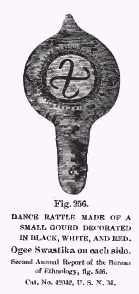

The Swastika
Dispersion of the Swastika
The Pueblos. --- The Pueblo country in Colorado, Utah, New Mexico, and Arizona, as is well known, is inhabited by various tribes of Indians speaking different languages, separated from one another and from all other tribes by differences of language, customs, and habit, but somewhat akin to each other in culture, and many things different from other tribes are peculiar to them. These have been called the "Peublo Indians" because they live in Pueblos or towns. Their present country includes the regions of the ancient cliff dwellers, of whom they are supposed to be the descendants. In those manifestations of culture where in they are peculiar and different form other tribes they have come to be considered something superior. Any search for the Swastika in American which omitted these Indians would be fatally defective, and so here it is found. Without speculating how the knowledge of the Swastika came to them, whether by independent invention or brought from distant lands, it will be enough to show its knowledge among and its use by peoples of this country.
In the Annual Report of the Bureau of Ethnology for the year 1880-81 (p. 394,
 fig.
562) is described a dance rattle made from a small gourd, ornamented in
black, while, and red (fig. 256). The gourd has a Swastika on each side,
with ends bent, not square, but ogee (the tetraskelion). The U. S. National
Museum possesses a large number of these dance rattles with Swastikas
on their sides, obtained from the Pueblo Indians of New Mexico and Arizona.
Some of them have the natural neck for a handle, as shown in the cut;
others are without neck, and have a wooden stick inserted and passed through
for a handle. Beans, pebbles, or similar objects are inside, and the shaking
of the machine makes a rattling noise which marks time for the dance.
fig.
562) is described a dance rattle made from a small gourd, ornamented in
black, while, and red (fig. 256). The gourd has a Swastika on each side,
with ends bent, not square, but ogee (the tetraskelion). The U. S. National
Museum possesses a large number of these dance rattles with Swastikas
on their sides, obtained from the Pueblo Indians of New Mexico and Arizona.
Some of them have the natural neck for a handle, as shown in the cut;
others are without neck, and have a wooden stick inserted and passed through
for a handle. Beans, pebbles, or similar objects are inside, and the shaking
of the machine makes a rattling noise which marks time for the dance.The Museum possesses a large series of pottery from the various pueblos of the Southwest; these are of the painted and decorated kind common to that civilization and country. Some of these pieces bear the Swastika mark; occasionally it is found outside, occasionally inside. It is more frequently of the ogee form, similar to that on the rattle from the same country (fig. 256). The larger proportion of these specimens comes from the pueblos of Santa Clara and St. Ildefonso.
<< Previous Page Next Page >>
© 2004-2007 Northvegr.
Most of the material on this site is in the public domain. However, many people have worked very hard to bring these texts to you so if you do use the work, we would appreciate it if you could give credit to both the Northvegr site and to the individuals who worked to bring you these texts. A small number of texts are copyrighted and cannot be used without the author's permission. Any text that is copyrighted will have a clear notation of such on the main index page for that text. Inquiries can be sent to info@northvegr.org. Northvegr™ and the Northvegr symbol are trademarks and service marks of the Northvegr Foundation.

|